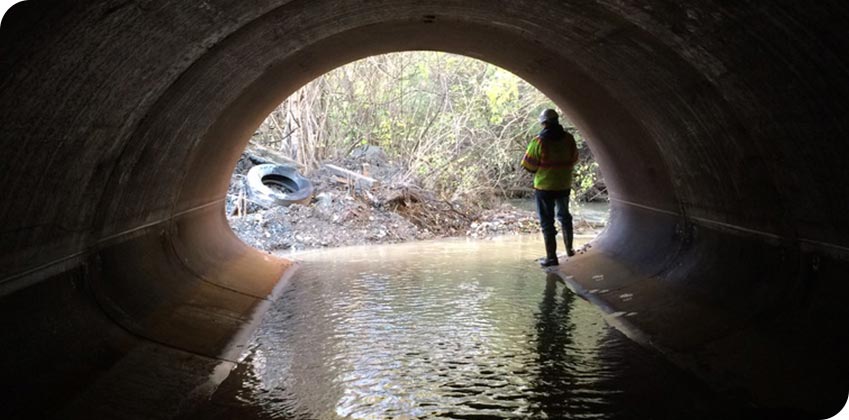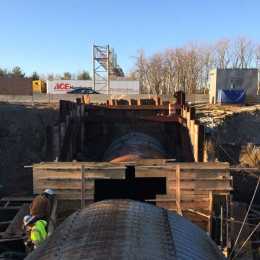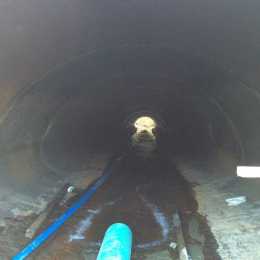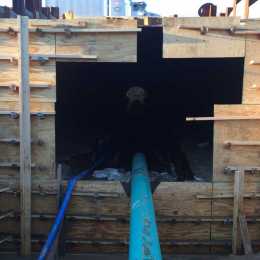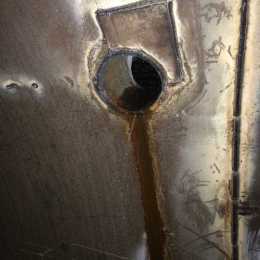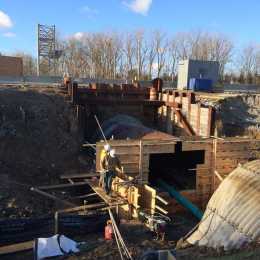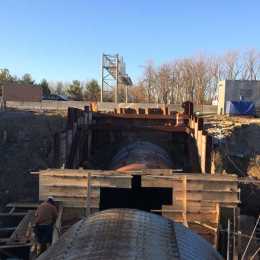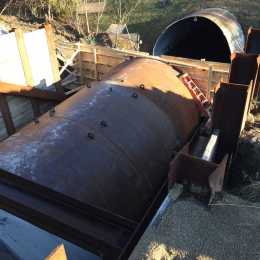Project Description
The Project
In October, 2012, the Indiana Department of Transportation Bridge Inspectors determined a large CMP Arch Pipe culvert with a span of 16’7” and a rise of 10’1” was failing under I-465 near Indianapolis. I-465 is a heavily used interstate bypass around Indianapolis, carrying up to 150,000 vehicles per day, of which fifteen percent are commercial vehicles. Originally noted for replacement, INDOT engineers determined that because of the cost and the effect on the traveling public, replacement was not an option.
Precision Pipe first inspected the failing structure in the Spring of 2013 to determine if their InfraSteel smooth wall carbon steel liner would be a good solution for repair. Other options considered by INDOT were round HDPE, spray-on poly, spray-on concrete, and a spiral- wound coil, which would act as a form for a grout liner reinforced with steel mats. Slip lining with HDPE would have reduced the hydraulic capacity to the extent that an additional bore adjacent to the original structure would have been necessary. There were also concerns about the structural value of the other materials considered.
The Challenge
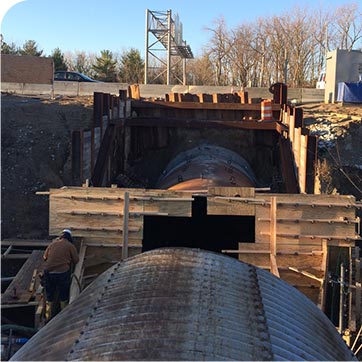
A lay-down yard was not possible due to concerns of the adjacent property owners, who also own Castleway Drive, which runs perpendicular to I-465 at the location. INDOT officials met with the property owners’ attorneys and condemnation was considered. Additionally, the property owners owned the pond, which provides the primary flow under Castleway Drive into the existing culvert.
After evaluating all known options for repair of the structure, INDOT determined that InfraSteel’s smooth-wall carbon steel liner would provide a cost-effective and environmental-friendly repair that was both structurally and hydraulically superior to the other methods considered. “We wanted something proven and you know what you are getting with steel”, said Douglas Dagley, INDOT engineer and project manager. Dagley also wanted a product that could be easily inspected and monitored over time, and InfraSteel required no lay-down yard.
In trying to determine the shape of the existing structure, Dagley was unable to find a match in any recent design manuals and he was informed by the CMP manufacturer that the host pipe was an odd shape that was only made for a couple of years in the 1970’s. Unexpectedly, on April 9, 2015, the existing CMP collapsed between the guardrail and Castleway Drive, two months before the job was scheduled to bid. A sinkhole quickly developed and a concrete barrier and shoring were installed, as a temporary fix until the project could be bid and InfraSteel could be installed.
The Solution
The best determined solution for the project was a 15’4” X 9’3” X 0.875 InfraSteel liner with an area of flow of 110 square feet, a liner with the maximum area of flow that could be slip lined into the host structure. Precision Pipe and Products worked with D.H. Charles Engineering of Santa Rosa, California to determine that an InfraSteel liner, with a thickness of 0.875”, satisfied HS-20-44 highway loadings with an assumed worst-case scenario of 7’ for soil-loading and 6’ for traffic loading. Also, it was decided that InfraSteel would be used to replace the collapsed section as a direct-bury installation, between the shoulder of I-465 and Castleway Drive.
On June 19, 2015, the job was let and Temple & Temple Excavating & Paving, Inc. of Salem, IN submitted the low bid of $896,000.00. Temple and Temple is an experienced contractor, whose subsidiary company T&T Pipe Renovations specializes in culvert rehabilitation. Eric Kennedy with Precision Pipe and Products, Inc. worked hand in hand with Temple & Temple Project Manager Patrick Howser to acquire the host structure measurements. In order for the InfraSteel liner to be made with the exact matching radii of the host pipe, detailed measurements were of the utmost importance. Precision Pipe and Products, Inc. has developed an intricate method of measuring and gathering information about the host pipe, which is provided to plant engineers so that they can convert the information into a matching liner. The plant engineers converted the measurements and provided drawings back to Temple & Temple who signed off on them so that production could begin.
Temple & Temple ordered the pipe in 8’-10’ lengths with inverted bevels so that all the welding could be done from inside the InfraSteel liner. The first load of the InfraSteel liner was delivered on September 29, 2015, to the I-465 Right of Way and offloaded from the trucks directly into the pit (that was created by the collapse and subsequent shoring and bracing) with a crane. No laydown yard was required. Temple & Temple’s ground crew used a telescoping forklift and operator to set the InfraSteel liner inside host structure in 4 days. Next up came crew of experienced welders who welded up the liner in 21 days, averaging one joint per day. Vertical drainage pipes from the I-465 median were cut and welded into the top of the InfraSteel liner to allow the median to drain inside the rehabilitated structure. The grouting process took 3 days to complete as 180 yards of grout was pumped into the annular space through grout tubes. The annular space was pressure-pumped in stages with the predetermined calculated volume of grout to ensure there were no voids between the new liner, the existing host pipe and the road.
Due to the collapse that took place in April, 2015, an extension of 30 to 40 feet towards Castleway Drive was necessary. Temple & Temple chose to use a flowable-fill grout poured up past the spring line, to give the direct-bury section a solid, stable base. The wood shoring had to be removed and the I Beams were left in place, but were cut down to 30” below grade. A headwall was constructed at the inlet end of the extension and 150 yards of rock and dirt was then used as fill for the area between the shoulder and the headwall.

